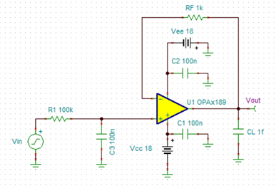Other Parts Discussed in Thread: OPA387, TINA-TI, , OPA182, OPA187, DAC8831
Tool/software:
Team,
I am considering using the OPAx189 as a low-pass filter buffer. This would just be a resistor and capacitor LPF, with an OPAx189 as a unity gain buffer on the output. For this example, suppose the resistor is 100kOhm and the capacitor is 0.1uF C0G. This would have a cutoff frequency of 15.9Hz.
Here are two questions about this circuit:
1. Our 100kOhm resistor is much larger than the recommended maximum input impedance of the OPAx189 (1kOhm, from SBOA586) to prevent noise and offset issues with charge injection ("chopper noise"). However, at the 150kHz chopping frequency, the input impedance drops to 10.6Ohms due to the capacitor. Is this arrangement going to have issues with chopper noise, or is the input impedance calculated at the chopping frequency for the purposes of the maximum?
2. Will there be any "integrating" effect done to the charge injection noise by the capacitor? Would one be more prominent if the filter cutoff is closer to the chopping frequency (let's say 15kHz instead of 10Hz)?
Thanks,
Jack Terrell










